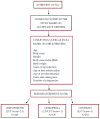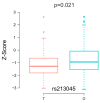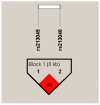The Analysis of ECE1 and PPARG Variants in the Development of Osteopenia and Osteoporosis in Postmenopausal Women
- PMID: 39062013
- PMCID: PMC11274254
- DOI: 10.3390/biomedicines12071440
The Analysis of ECE1 and PPARG Variants in the Development of Osteopenia and Osteoporosis in Postmenopausal Women
Abstract
Osteoporosis is a multifactorial systemic skeletal disease that is characterized by a low bone mineral density (BMD) and the microarchitectural deterioration of bone tissue, leading to bone fragility. The search for new genes that may play an important role in the regulation of bone mass and the development of osteoporosis is ongoing. Recently, it was found that altering the activity of the endothelin-1-converting enzyme encoded by the ECE1 gene may affect bone mineral density (BMD). Another gene involved in the process of osteoblast differentiation and maturation is believed to be PPARG (peroxisome proliferator-activated receptor gamma). This participates in regulating the transformation of stem cells and affects the process of bone formation and resorption. Therefore, we analyzed the association of the ECE1 and PPARG variants with osteopenia and osteoporosis risk in the Polish population. This study included a group (n = 608) of unrelated Polish women (245 individuals with osteoporosis (aged: 57 ± 9), 109 individuals with osteopenia (aged: 53 ± 8) and 254 healthy controls (aged: 54 ± 8)). The real-time PCR technique was used to determine the genetic variants for rs213045 (-338G>T) and rs213046 (-839A>C) of the ECE1 gene and rs1801282 (Pro12Ala, C>G) of the PPARG gene. Analysis of the PPARG rs1801282 variants did not show any association with the risk of osteoporosis and osteopenia. However, in the densitometric results, lower median Z-score values were observed for the T allele compared to the G allele for the rs213045 variant of the ECE1 gene (-1.11 ± 1.07 vs. -0.78 ± 1.21, p = 0.021). Moreover, the TT genotype for the rs213045 variant was more common in women with osteopenia (13.8%, OR = 2.82, p < 0.05) and osteoporosis (7.8%, OR = 1.38, p > 0.05) compared to the control group (5.5%). Additionally, our results suggested that the T allele of rs213045 was more common in women with osteopenia compared to the controls. We further observed that the haplotype containing two major GA alleles of ECE1 (rs213045, rs213046) could reduce the risk of osteopenia in our population. Finally, we found that women with osteoporosis had statistically significantly lower body mass and BMI values compared to the control group. Our results suggest that the ECE1 rs213045 variant may increase the risk of osteopenia. However, the data obtained require confirmation in further studies.
Keywords: ECE1; PPARG; allelic variants; osteoporosis; polymerase chain reaction.
Conflict of interest statement
The authors declare no conflicts of interest.
Figures
Similar articles
-
Osteoprotegerin Gene as a Biomarker in the Development of Osteoporosis in Postmenopausal Women.Biomedicines. 2023 Dec 4;11(12):3218. doi: 10.3390/biomedicines11123218. Biomedicines. 2023. PMID: 38137439 Free PMC article.
-
Polymorphisms of ECE1 may contribute to susceptibility to ischemic stroke in Han Chinese of Northern China.Cell Biochem Biophys. 2014 Jun;69(2):237-46. doi: 10.1007/s12013-013-9789-z. Cell Biochem Biophys. 2014. PMID: 24595843
-
[PvuII genetic polymorphism of estrogen receptor alpha in the group of postmenopausal women with osteopenia and osteoporosis].Ginekol Pol. 2005 Sep;76(9):679-86. Ginekol Pol. 2005. PMID: 16417078 Clinical Trial. Polish.
-
The -839(A/C) Polymorphism in the ECE1 Isoform b Promoter Associates With Osteoporosis and Fractures.J Endocr Soc. 2019 Jul 15;3(11):2041-2050. doi: 10.1210/js.2019-00057. eCollection 2019 Nov 1. J Endocr Soc. 2019. PMID: 31637345 Free PMC article.
-
The Association Between the Concentration of Serum Magnesium and Postmenopausal Osteoporosis.Front Med (Lausanne). 2020 Aug 4;7:381. doi: 10.3389/fmed.2020.00381. eCollection 2020. Front Med (Lausanne). 2020. PMID: 32850896 Free PMC article.
References
-
- Kragl A., Hannemann A., Nauck M., Völker U., Siggelkow H., Teumer A., Tzvetkov M.V. Genetic Variants in WNT16 and PKD2L1 Locus Affect Heel Ultrasound Bone Stiffness: Analyses from the General Population and Patients Evaluated for Osteoporosis. Calcif. Tissue Int. 2023;113:540–551. doi: 10.1007/s00223-023-01141-9. - DOI - PMC - PubMed
LinkOut - more resources
Full Text Sources




